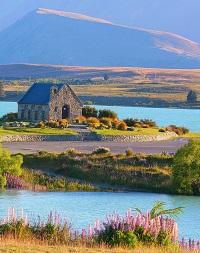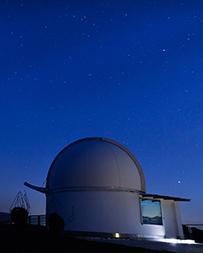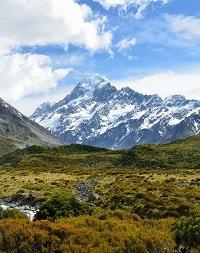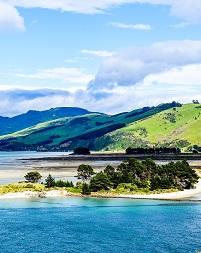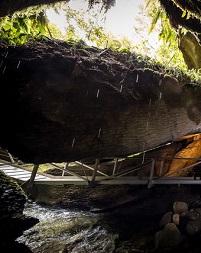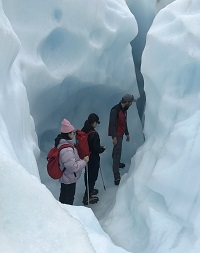Educational Trip to New Zealand South Island for International Schools
The South Island has it all; turquoise lakes, glaciers, spectacular mountain peaks, picture perfect towns and epic activities for your next school trip!
Highlights
Geography
Cultural
History
CAS
What's included
Subject based excursions
The last ice-age 15,000 to 18,000 years ago saw huge glaciers, longer than the lake, depositing large volumes of rock, damming the valley to form Lake Tekapo. The glaciers have since retreated to the valleys at the head of the lake. The Mackenzie Basin was free of humans until with the arrival of the Maori several hundred years ago. In 1857 the first sheep farm was established, a hotel appeared in 1861 and in the 1930s, work began on Tekapo power station. Today beautiful Lake Tekapo has become a popular tourist destination.
As conditions permit, our astronomy guides to help you navigate the southern night sky using green laser pointers. Experience the thrill of peering through powerful telescopes and binoculars to see amazing sights, both near and far. When stars are hidden from sight, discover the nocturnal world of an astronomer behind the scenes.
Aoraki/Mount Cook is New Zealand’s great alpine park. It has the highest mountains and the largest glaciers. Aoraki/Mount Cook Village and all visitors to the park are dwarfed by the immensity of the landscape that surrounds them.
- Drive to Mount Cook National Park.
- Walk the Sealy Tarns Track (moderate to difficult) or Hooker Valley Track (easy) (3 – 4 hours return)
These beautiful walks allow spectacular views of the Hooker Valley and the peaks of the area including Aoraki/Mount Cook. An abundance of alpine flowers in summer, and the view from the tarns makes the effort worthwhile. Study high altitude ecosystems (altitudinal zonation, adaptive radiation and adaptations of alpine species to extreme environmental conditions).
Known as the Edinburgh of New Zealand, Dunedin wears its Scottish heritage with pride. Surrounded by dramatic hills and at the foot of a long harbour, Dunedin is one of the best-preserved Victorian and Edwardian cities in the Southern Hemisphere. On Dunedin’s doorstep you will find incredible wildlife including the world’s rarest penguins and, at Taiaroa Head, the world’s only mainland breeding colony of Royal Albatross. Visit the steepest street in the world, go to Benmore hydro-station, the country’s largest man-made lake. Go on the Mt Cook and Lake Pukaki lookout and discuss the orogeny of the Southern Alps and their modification by glacial activity. If time allows, explore the Duntroon fossil trail, with more than 20 sites related to landforms, distinctive rocks, minerals and fossils, covers coastal sites from Moeraki to Oamaru, including the well-known Moeraki Boulders.
Visit the university marine lab, collect data on community or population patterns in relation to biotic and abiotic factors in the environment. Discuss environmental conditions in relation to adaptations and community and population patterns. Plus, explore the rocky shore of Otago Harbour.
The serene deep waters of Lake Te Anau make up the largest lake in the South Island and second largest in NZ and are bordered on its western shore by lush virgin forest. The town of Te Anau, the ‘gateway to the fiords’ lies nestled on the edge of this beautiful lake, with a spectacular backdrop of Mt Luxmore and the Murchison mountains. Te Anau itself has mainly built up as a launch point for the Milford Track and other tracks in the region. Located on the western shores of Lake Te Anau and reached by boat, the caves are famous for their beautiful formations, their rushing white water and whirlpools and their magical glowworms.
The Southern Alps would be growing upwards at a rate of one centimetre a year if it wasn’t for the forces of erosion. Go back in time geologically, meeting the oldest rocks in New Zealand, remnants of the super-continent, Gondwanaland, along the west coast. Stop at Fruit Barn for a ice-cream, visit a deer farm, including venison tasting. Take a scenic drive along shores of Lake Wanaka and through Haast Pass where you’ll find waterfalls and dramatic gorges, then drive north though Westland National Park, perfect for a beach picnic and a short walk. There you might see seals or Fiordland crested penguins.
read more
Coastal Processes study in Haast:
o Visit lookout or similar high point for overview of the coastal landforms and patterns of land use. Discuss coastal processes and the dynamic nature of coast-lines.
o Exhibition/DVD at Department of Conservation visitor centre on the local environment including aggradation since the end of the last glacial, human impacts and their management.
o Data collection: beach profile, vegetation transect, velocity of longshore drift.
Lake Matheson is a photographer’s dream, as its crystal waters create a mirror image of New Zealand’s highest peaks, Aoraki (Mt Cook) and Mt Tasman. The track encircles the lake, through native rainforest, and it takes approximately one hour to walk the entire lake circuit.
read moreThe West Coast glaciers are among the fastest moving in the world, up to 4 metres a day, because of their large catchments and this is why they extend down into the forest. During the last Ice Age, they reached far beyond the current coastline, with the result that glacial land-forms feature prominently along the west coast of the South Island. For many, the Fox and Franz Josef glaciers are the main reason to visit but between the glaciers and the sea is also a bird watcher’s paradise. Rainforest and large areas of wetland shelter rare species such as the Okarito Brown Kiwi and White Heron (kotuku).
The Christchurch area was first settled by moa-hunting tribes about 1250 CE. Following the purchase of land by whalers, a party of European settlers established themselves in what is now Christchurch in the 1840s. In December 1850 four ships brought to the area 792 settlers with aspirations of building a city around a cathedral and college like Christ Church in Oxford. Now New Zealand’s second-largest city, Christchurch was hit by a huge earthquake in February 2011. Much of the central city with its classic neo-gothic architecture was destroyed. However, it remains a beautiful city: the buildings may have been damaged but the soul of the city and the welcoming spirit of the people are very much intact.
